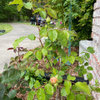Rose Cutting Question
kotzurc
16 years ago
Related Stories

Easy Green: 6 Must-Answer Questions Before You Buy
Thinking about buying ecofriendly furniture? For a truly environmentally conscious home, ask yourself these questions first
Full Story
REMODELING GUIDES13 Essential Questions to Ask Yourself Before Tackling a Renovation
No one knows you better than yourself, so to get the remodel you truly want, consider these questions first
Full Story
KITCHEN DESIGN9 Questions to Ask When Planning a Kitchen Pantry
Avoid blunders and get the storage space and layout you need by asking these questions before you begin
Full Story
REMODELING GUIDESSurvive Your Home Remodel: 11 Must-Ask Questions
Plan ahead to keep minor hassles from turning into major headaches during an extensive renovation
Full Story
REMODELING GUIDES9 Hard Questions to Ask When Shopping for Stone
Learn all about stone sizes, cracks, color issues and more so problems don't chip away at your design happiness later
Full Story
SELLING YOUR HOUSE15 Questions to Ask When Interviewing a Real Estate Agent
Here’s what you should find out before selecting an agent to sell your home
Full Story
LIGHTING5 Questions to Ask for the Best Room Lighting
Get your overhead, task and accent lighting right for decorative beauty, less eyestrain and a focus exactly where you want
Full Story
WORKING WITH PROS12 Questions Your Interior Designer Should Ask You
The best decorators aren’t dictators — and they’re not mind readers either. To understand your tastes, they need this essential info
Full Story
DOORS5 Questions to Ask Before Installing a Barn Door
Find out whether that barn door you love is the right solution for your space
Full Story
GREEN BUILDINGConsidering Concrete Floors? 3 Green-Minded Questions to Ask
Learn what’s in your concrete and about sustainability to make a healthy choice for your home and the earth
Full StoryMore Discussions









dan_keil_cr Keil
sandy808
Related Professionals
Canton Landscape Architects & Landscape Designers · Carlisle Landscape Architects & Landscape Designers · Comstock Park Landscape Architects & Landscape Designers · Roosevelt Landscape Architects & Landscape Designers · West Chester Landscape Architects & Landscape Designers · Hartford Landscape Contractors · Deerfield Landscape Contractors · Fair Oaks Landscape Contractors · Fort Atkinson Landscape Contractors · Secaucus Landscape Contractors · Stony Brook Landscape Contractors · Greenfield Landscape Contractors · Northlake Landscape Contractors · Norridge Landscape Contractors · North Hills Landscape Contractorscecily
gnabonnand
gnabonnand
sandy808
ceterum
bob-2007
berndoodle
ceterum
ehann
berndoodle
mgleason56
ceterum
ceterum
mgleason56